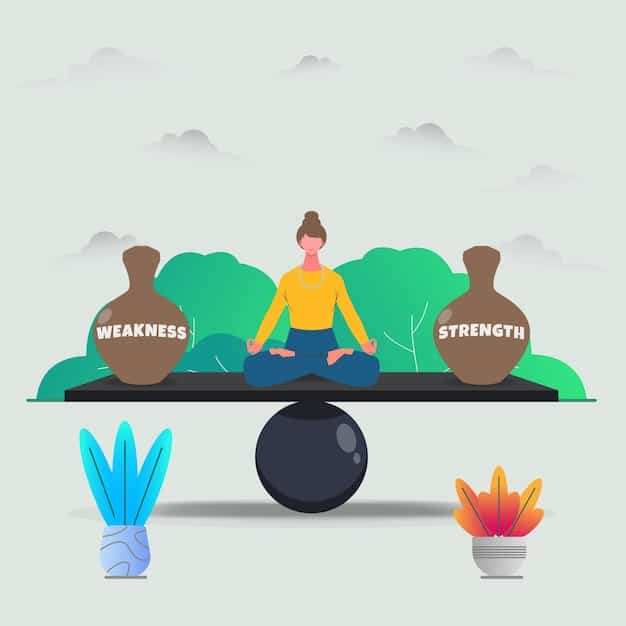Boost Emotional Resilience: A Beginner’s Guide to Mindfulness

Mindfulness offers a potent toolkit for boosting emotional resilience in beginners, helping individuals navigate stress and setbacks with greater ease and balance, fostering mental well-being.
In today’s fast-paced world, how mindfulness can boost your emotional resilience: a practical guide for beginners is more relevant than ever. Learning to navigate life’s inevitable ups and downs with grace and strength begins with understanding and practicing mindfulness.
Understanding Emotional Resilience and Its Importance
Emotional resilience is your ability to bounce back from adversity, stress, and challenges. It’s not about avoiding difficult emotions, but rather navigating them effectively and emerging stronger.
Cultivating emotional resilience is vital for overall well-being. It allows you to handle stress more effectively, maintain healthy relationships, and achieve your goals despite obstacles.
What Does Emotional Resilience Look Like?
Emotional resilience presents itself in numerous ways, many of which manifest in the way one reacts to stressful situations. Resilient individuals are not immune to stressful encounters, but rather they have developed personal strategies that promote effective management of challenging times in their lives.
- Adaptability: Bouncing back from setbacks and adjusting to new situations.
- Optimism: Maintaining a positive outlook even during tough times.
- Self-Awareness: Understanding your emotions and how they affect you.
- Strong Relationships: Leaning on a supportive network of friends and family.
Ultimately, resilience is a tool to utilize when navigating the tumultuous currents of life. When one has developed heightened resilience, their encounters with challenges are rendered a little more manageable.. It’s a quality that enriches our lives, making us more adaptable and stronger when we come face to face with adversity.

Mindfulness: A Foundation for Emotional Resilience
Mindfulness is the practice of paying attention to the present moment without judgment. It involves focusing on your thoughts, feelings, and sensations as they arise, without getting carried away by them.
Mindfulness practices can significantly enhance your emotional resilience by increasing self-awareness, reducing reactivity, and promoting a sense of calm and clarity.
How Mindfulness Works
At its core, mindfulness is about cultivating a different relationship with your thoughts and feelings. You learn to observe them without immediately reacting, allowing you to make more thoughtful and intentional choices.
- Reduces Stress: By focusing on the present, mindfulness can reduce anxiety and worry about the future or regret about the past.
- Increases Self-Awareness: Mindfulness helps you become more aware of your emotional triggers and patterns.
- Enhances Emotional Regulation: It gives you space to respond to emotions rather than react impulsively.
- Promotes Compassion: Mindfulness fosters kindness and understanding toward yourself and others.
By practicing this ancient art, the mind can be trained to be more resilient and better prepared to withstand adversity. It’s about acknowledging stress and feelings without letting them dictate our actions.
Simple Mindfulness Exercises for Beginners
Starting with mindfulness doesn’t require extensive training or special equipment. Simple exercises can be integrated into your daily routine to begin developing your practice.
These exercises are designed to be accessible, even for those with busy schedules or no prior experience with mindfulness. Consistency is key, so start with small increments and gradually increase the duration as you become more comfortable.
Breathing Awareness
Focusing on the breath is a foundational mindfulness practice. It involves paying attention to the sensation of each inhale and exhale, noticing the rise and fall of your chest or abdomen.
To practice, find a quiet space, sit comfortably, and close your eyes. Bring your attention to your breath, noticing the natural rhythm without trying to change it. When your mind wanders, gently guide your focus back to your breath.

Mindful Walking
Mindful walking involves paying attention to the sensation of your feet making contact with the ground as you walk. Notice the movement of your body, the air on your skin, and any sounds around you.
To practice mindful walking, choose a safe and quiet location. Walk at a slow and deliberate pace, focusing on the physical sensations of each step. Let go of distractions and immerse yourself in the experience of walking.
Body Scan Meditation
A body scan meditation involves bringing awareness to different parts of your body, noticing any sensations without judgment. This practice can help you become more attuned to your physical and emotional state.
To practice, lie down comfortably and close your eyes. Start by focusing on your toes, noticing any sensations such as tingling, warmth, or pressure. Gradually move your attention up your body, scanning each body part with curiosity and acceptance.
Benefits of Body Scan Meditation
Body scan meditation not only grounds you but also is extremely beneficial in bringing awareness to feelings one may be neglecting in the body. Ultimately, this cultivates further mindfulness and emotional resilience.
- Promotes Relaxation: Reduces muscle tension and calms the nervous system.
- Increases Body Awareness: Helps you become more attuned to your physical sensations.
- Enhances Emotional Regulation: Gives you insight into how emotions manifest in your body.
The benefits are vast and deeply integral in the work of building a stronger sense of awareness and ability to regulate emotions in times of stress. With practice, this particular meditation can be incredibly influential for emotional healing.
Integrating Mindfulness into Daily Life
Mindfulness isn’t just something you practice during formal meditation sessions. It can be integrated into your daily life, transforming routine activities into opportunities for present moment awareness.
By bringing mindfulness to everyday tasks, you can cultivate a more grounded and centered approach to life, enhancing your emotional resilience in the process.
Mindful Eating
Mindful eating involves paying attention to the taste, texture, and aroma of your food as you eat. It’s about savoring each bite and noticing how your body responds to the nourishment.
Mindful Communication
Mindful communication involves listening attentively to others without interrupting or formulating your response. It’s about being fully present and engaged in the conversation.
- Active Listening: Fully focusing on what the other person is saying without judgment.
- Non-Reactivity: Pausing before responding to allow yourself time to process your emotions.
- Empathy: Understanding and acknowledging the other person’s feelings.
In integrating mindfulness into these practices, one is more equipped to handle conflict and disagreements in a more gentle and meaningful manner. Often, conflict occurs due to a lack of mindfulness and emotional awareness of others.
Overcoming Challenges in Your Mindfulness Journey
As with any new skill, practicing mindfulness can come with challenges. It’s important to be patient with yourself and to approach your practice with compassion and acceptance.
Common challenges include a wandering mind, restlessness, and frustration. These challenges are normal and can be overcome with persistence and self-compassion.
Dealing with a Wandering Mind
It’s natural for your mind to wander during mindfulness practice. When this happens, simply acknowledge the thought without judgment and gently redirect your attention back to your breath or chosen focus.
- Acknowledge and Redirect: Don’t criticize yourself for getting distracted; simply bring your focus back.
- Use Anchors: Focus on a specific sensation, such as your breath or the feeling of your feet on the ground.
- Practice Regularly: The more you practice, the easier it will become to maintain focus.
Ultimately, it’s okay to have a wandering mind. It’s only human. So long as one acknowledges it with love and softness, redirecting to the task will yield even better results than before.
| Key Point | Brief Description |
|---|---|
| 🧘 Mindfulness | Paying attention to the present moment without judgment. |
| 🌬️ Breathing Awareness | Focusing on the sensation of each inhale and exhale. |
| 🚶 Mindful Walking | Paying attention to the sensation of your feet making contact with the ground. |
| 👂 Mindful Communication | Listening attentively to others without interrupting. |
Frequently Asked Questions (FAQ)
▼
Emotional resilience is the ability to bounce back from difficult experiences. It’s about how quickly you recover from adversity and move forward with strength.
▼
Mindfulness increases self-awareness, reduces reactivity, and promotes a calm mind. These qualities help you manage emotions and cope with stress effectively.
▼
Yes, mindfulness has been shown to reduce stress, improve focus, and enhance emotional well-being. Regular practice can lead to significant positive changes.
▼
No, even short periods of mindfulness practice, such as 5-10 minutes a day, can be beneficial. Consistency is more important than duration.
▼
Results vary, but many people experience positive changes within a few weeks of consistent practice. The key is to be patient and persistent.
Conclusion
Integrating mindfulness into your daily life offers a powerful pathway to boost your emotional resilience. By starting with simple exercises and remaining patient with your progress, you can cultivate a greater sense of calm, clarity, and strength in the face of life’s inevitable challenges.





